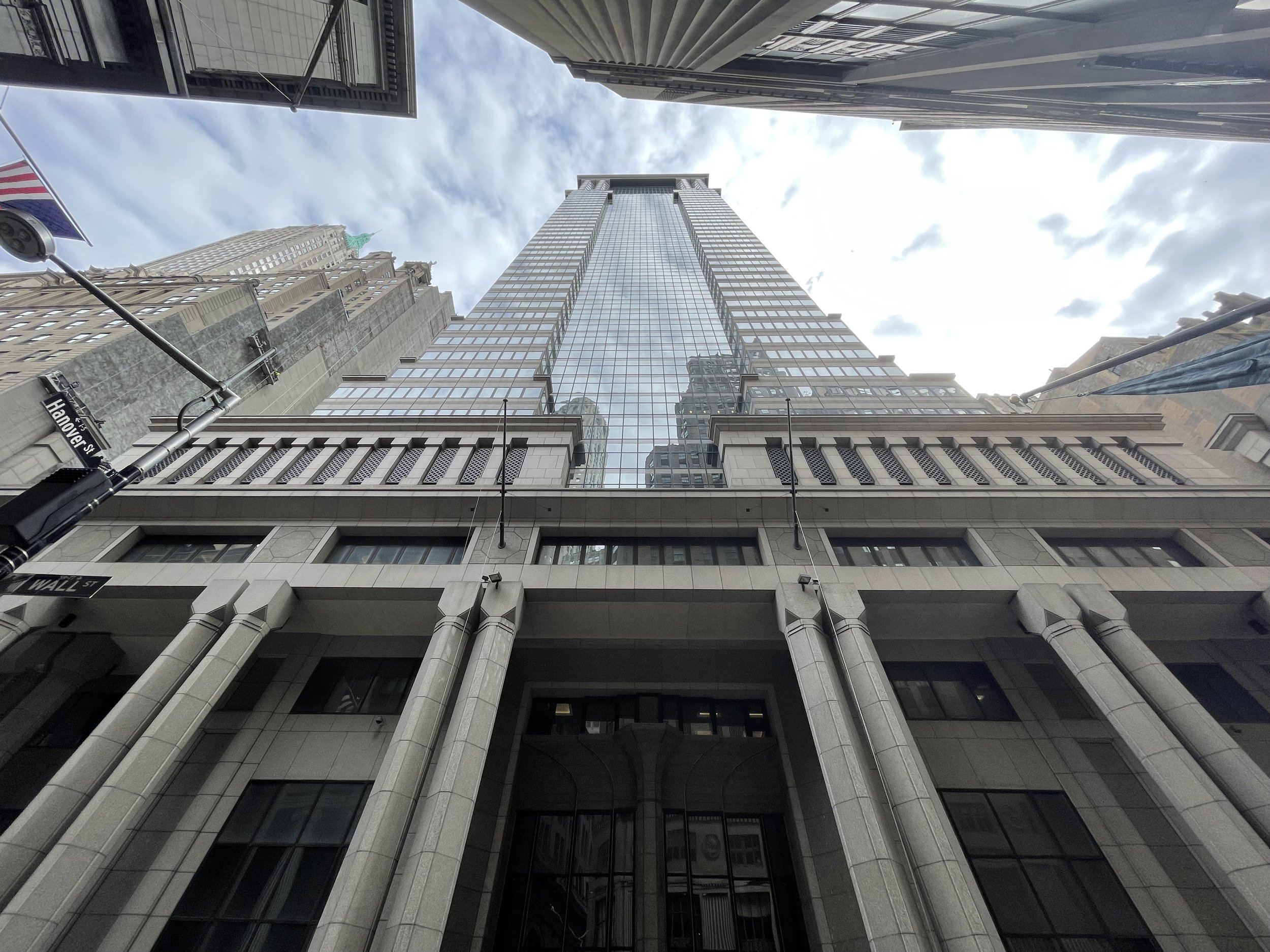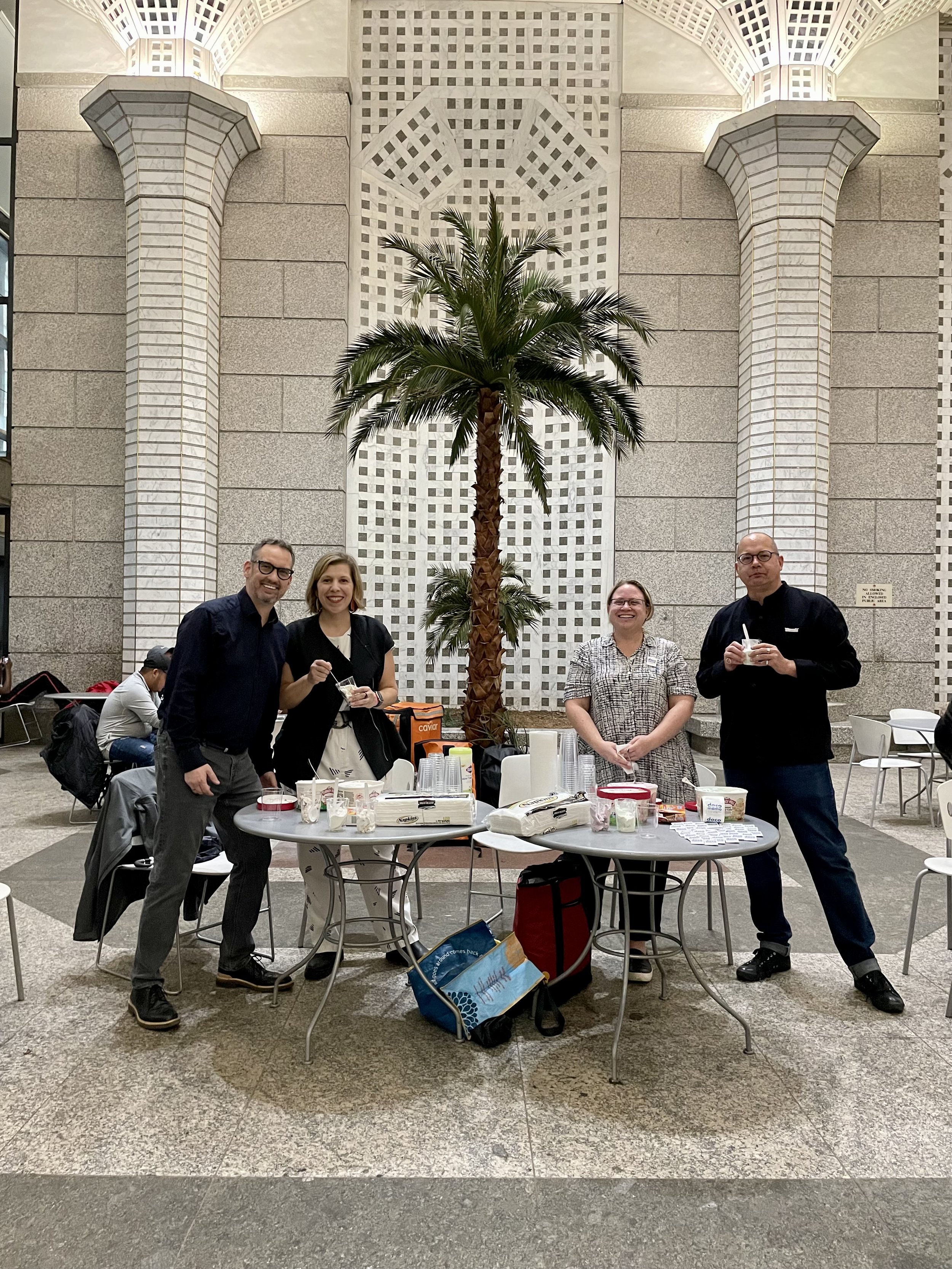Pragmatic Preservationist: Docomomo's Liz Waytkus on Modern Architecture, Advocacy, and Natalie DeBlois
By Julia Gamolina
Liz Waytkus is the Executive Director of Docomomo US. In her decade at Docomomo US, Liz developed the National Symposium and the Modernism in America Awards. Liz manages Docomomo US’ advocacy and spear-headed efforts to Landmark the Ambassador Grill and the AT&T Building in New York City. She received her Master of Science in Historic Preservation from Pratt Institute and previously worked in the non-profit cultural and educational fields for more than a decade. In her interview, Liz talks about her work advocating for and saving Modern architecture, advising those just starting their careers to not second guess their passions.
JG: You studied historic preservation at Pratt — tell me how you came to this focus, and why Pratt.
LW: Pratt’s architecture and preservation program spoke to me because it felt welcoming of different opinions and viewpoints on architecture. I decided to go back to school for architecture after a number of years in the arts and education. Focusing on historic preservation was a better fit for me than straight architecture because of my diverse interests and all of the various paths you can take with that degree.
Pratt’s historic preservation program is also grounded in community outreach and participation, which really called to me. I’m a pragmatic preservationist. If we are going to save architecture of the 20th century, especially with sites that are misunderstood and often disliked by the public, we need an all-hands-on-deck approach. Having that experience at Pratt working with the public and public institutions was critical for me.
Sarasota Architecture Foundation MOD event at Sarasota High School, 2015. Photo courtesy of Sarasota Architecture Foundation.
How did you get to Docomomo? Tell me about your role and what you're focused on these days.
[Laughs] I like to say that I’m still in my college internship. Theo Prudon, the founding president of Docomomo US was my professor at Pratt. After realizing my fellow classmates didn’t love Modernism as much as I did, I went up to him at the end of the semester and asked if there were internship opportunities. I’ve been at Docomomo US ever since. As the first Executive Director of Docomomo US, the position has allowed me to shape the organization and our programs. I do a little bit of everything, but what brings me the most satisfaction is working on advocacy issues. I spend a good amount of time assisting individuals and other organizations all over the country in their efforts to educate communities on the values of preserving Modern design. We helped our colleagues in Sarasota avoid the demolition of a portion of the Paul Rudolph designed Sarasota High School.
Right now, I am focused on saving the Kevin Roche designed 60 Wall Street in lower Manhattan. It’s a project from 1989 and designed at the height of Post Modernism. Modernists are not the biggest fans of exaggerated columns, decoration, and whimsy, but the architecture community has really come around and agrees the building and its privately owned public space are worthy of New York City Landmark designation. Plus, younger generations and creative types love it! Companies are trying to create Instagram-worthy spaces and this developer is trying to destroy it. It remains to be seen if the interior will be demolished or not, but we will keep advocating for it and other more recent significant sites.
“My favorite woman architect that everyone should know about is Natalie DeBlois. This lady built skyscrapers at a time when she was not allowed to participate in client meetings.”
Looking back at it all, what have been your biggest challenges? How did you both manage through perceived disappointments or setbacks?
Seeing a project get torn down and thinking this absolutely should not be happening is always hard. The demolition of Prentice Women’s Hospital in Chicago by Bertrand Goldberg was my first real disappointment. When we lose a building, it is important we use it a teaching tool. There can be value even in a loss.
I was gutwrenchted when Marcel Breuer’s Geller House on Long Island was demolished. I spent my whole Christmas vacation pleading with local municipalities and the homeowners to give us some time to find a solution. These people don’t know me and didn’t want to be told by an outsider what to do. Once I started doing the research about the house, I realized this was the project that got Breuer the big House in the Garden show at MoMA in 1949. This was right after he split from Gropius in Massachusetts and an important pivot point in home design. With Geller I knew we had to do everything in our power to try to stop the demolition or at least tell the story about the house. And as they say, in the dead of night the bulldozers came…That loss was hugely disappointing; they replaced it with a tennis court. Disappointments are always tough, but it makes us stronger and hopefully smarter.
We tend to associate Modernism with Frank Lloyd Wright, Le Corbusier, Mies . . . tell me about architects that were women who were key to the Modernism movement, and who everyone should know about.
My favorite woman architect that everyone should know about is Natalie DeBlois. This lady built skyscrapers at a time when she was not allowed to participate in client meetings. She was so incredibly talented, and her design skills were highly respected. Can you imagine working next to Louis Skidmore and Gordon Bunshaft and holding your own?
There is a great video of her participating in the television series To Tell the Truth from 1958. It must have been outrageous to think a woman could design a skyscraper. Even today the list of female skyscraper architects is pretty low. Her story is an inspiration in perseverance.
Exterior 60 Wall Street designed by Kevin Roche John Dinkeloo and Associates. Photo courtesy of Liz Waytkus.
Liz Waytkus at 60 Wall Street during Docomomo US ice cream social popup advocacy event. Photo courtesy of Docomomo US.
What have you also learned in the last six months?
I’ve learned to trust my gut more and work with people who may be outside of the mainstream of our profession. In our fight to save 60 Wall Street, Dodai Stuart, a Metro desk writer for the New York Times and a founding editor of Jezebel, wrote a really lively article and quoted me alongside Rock Herzog of Cocaine Décor. I love what Rock’s doing; highlighting the aesthetics of the 1980s and how fun and imaginative designs were of that period.
Before the article I thought Cocaine Décor’s social media was a bit of a hoot. After the article came out, I realized Rock and I were educating people on architecture and design but coming at it from different angles. Rock is also working on highlighting interior designers of the 1980s, many of which were hugely impacted by the AIDS crisis. All of these topics are conversations we should be having.
What are you most excited about right now?
I love architecture of the latter half of the 20th century. I’m also Gen X so the weirder, lesser known and less understood the better. Take me to a mirror glass suburban office park and I’m like a kid in a candy store exploring and looking at designs that no one is looking at yet. It is all hiding in plain sight and some of this stuff is big! I enjoy seeing the work of my peers like the architectural historian Daniel Paul in California. He just designated the New City of Mentalphysics in Joshua Tree and is working to help designate The Last Resort in San Francisco.
“I am always thinking that in thirty years, someone like me will be looking at the projects of the 21st century and will have to decide what was good and what we should preserve.”
Who are you admiring now and why?
I love the work of the Beverly Willis Architecture Foundation. Their podcast New Angle Voice is terrific and tells the stories of women in architecture. It’s real storytelling and you always come away saying, “Why didn’t I know that?”
There's also a new group that's popped up in the Hamptons called Hamptons 20th Century Modern led by Tim Godbold who are doing a great job making people aware of the resources out there. High land values and older, smaller houses are not a good combination. It's been great watching Tim's new group rise to what's happening and make people aware these houses are architecturally significant and highly appealing. Like me, Tim also enjoys the funky stuff from the 70s and 80s.
Design-wise I’ll admit I don’t pay too much attention to contemporary design because I have a whole other century that I’m responsible for. But I am always thinking that in thirty years, someone like me will be looking at the projects of the 21st century and will have to decide what was good and what we should preserve.
My eyes are trained on that when I see new architecture. But if we’re talking about the past my most recent obsessions are Geoffrey Bawa, Julian Lampens, Judith Chafee and Alfred Clauss and Jane West Clauss. The Clauss’ are still a bit of an unknown, but they are former employees of Mies van der Rohe and Le Corbusier respectively. Two of their buildings were just torn down in New Jersey and then we gave an award for the restoration of a home they designed in a unique housing development they created in Knoxville, Tennessee. Discovering new designers like that is very exciting.
What is the impact you’d like to have on the world? What is your core mission? And what does success in that look like to you?
Success to me is enjoying what I do, having great people around me and feeling like I made a difference. Designating the Ambassador Grill in the UN Plaza Hotel designed by Kevin Roche John Dinkeloo and Associates as a New York City Landmark was so impactful for me. It was the first time I led a coalition to landmark a building and we were successful. To think people from all over the world can come and see such great spaces and know they are preserved because of my actions is very humbling. I would love to think I helped change some hearts and minds in terms of preserving Modernism. Everyone doesn’t need to be a Kool-Aid drinker but it’s a great feeling when regular people say, “Oh yeah, I love that space.”
Liz Waytkus at the Beinecke Rare Book and Manuscript Library during the Docomomo US National Symposium in New Haven, CT 2023. Photo by Michael Morand, Director of Community Engagement at Beinecke Library at Yale University.
Finally, what advice do you have for those starting their career? Would your advice be any different for women?
Finding my path into architecture was not easy nor was it direct. I would say most importantly stay true to yourself and don’t second guess your path. Every point in your journey is taking you somewhere that no one else has been. If you get off track, take leaps of faith and follow your instincts. Travel as much as you can, see as much art as you can, experience different cultures and just keep learning and listening. My advice specifically for women is to support each other. I would be lost without my female friends.
This interview has been edited and condensed for clarity.




